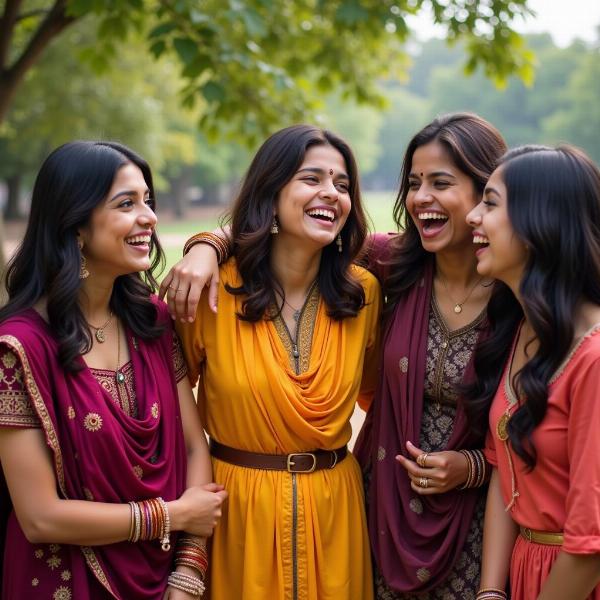We love meaning in Hindi delves into the rich nuances of expressing affection in India’s most widely spoken language. Understanding the cultural context behind these expressions is key to truly appreciating their depth and significance. Whether you’re learning Hindi, exploring Indian culture, or simply curious about the language of love, this article will provide valuable insights into the various ways “we love” is conveyed in Hindi.
Exploring “We Love” in Hindi
Hindi offers a diverse range of expressions to convey love, going beyond a simple translation. The words chosen often reflect the relationship’s nature, the level of intimacy, and the cultural context. Unlike English, which primarily relies on “love,” Hindi incorporates words like “pyaar” (प्यार), “prem” (प्रेम), “sneha” (स्नेह), and “mohbbat” (मोहब्बत), each with its unique shade of meaning.
Different Shades of Love: Pyaar, Prem, Sneha, and Mohbbat
“Pyaar” is perhaps the most common term for love, encompassing romantic love, familial affection, and even platonic love for friends. “Prem,” while also meaning love, carries a deeper, more spiritual connotation, often associated with divine love or unconditional love for humanity. “Sneha” denotes affection and tenderness, often used within families or close-knit communities. Finally, “mohbbat” represents a passionate, intense love, often found in poetry and romantic literature.
What if we want to express “we love” in a familial context? In Hindi, we might say “hum pyaar karte hain” (हम प्यार करते हैं) or “hum sab ek doosre se pyaar karte hain” (हम सब एक दूसरे से प्यार करते हैं) which translates to “we all love each other.” The addition of “sab” (all) emphasizes the collective nature of the love within the family.
Expressing Love Beyond Words
Indian culture often expresses love through actions rather than words. Gestures like touching the feet of elders as a sign of respect, sharing food, and participating in family rituals all convey deep affection. These non-verbal cues are integral to understanding the expression of love in Indian society.
“We Love” in Different Relationships
The way “we love” is expressed in Hindi varies significantly depending on the relationship. Between romantic partners, the language might be more passionate and intimate. Within families, affection is often expressed through acts of service and shared experiences. Among friends, the language is more casual and playful.
Romantic Love in Hindi
Romantic love is often expressed using endearing terms and poetic language. Phrases like “meri jaan” (मेरी जान – my life), “mere dil ki dhadkan” ( मेरे दिल की धड़कन – heartbeat of my heart), and “mera pyaar” ( मेरा प्यार – my love) are common expressions of deep affection.
Familial Love in Hindi
Within families, respect and love are intertwined. Terms like “maa” (माँ – mother), “pita” (पिता – father), “bhai” (भाई – brother), and “behen” (बहन – sister) carry inherent affection. Expressions like “hum tumse pyaar karte hain” (हम तुमसे प्यार करते हैं – we love you) are common, but the depth of emotion is often conveyed through actions and shared experiences.
Platonic Love in Hindi
Among friends, the language of love is more casual. Terms like “dost” (दोस्त – friend) and “yaar” (यार – friend/buddy) are frequently used. Phrases like “hum tumhe pasand karte hain” (हम तुम्हें पसंद करते हैं – we like you) or “tum bahut achchhe ho” (तुम बहुत अच्छे हो – you are very good) can also convey affection in a platonic context.
We Love Meaning in Hindi: A Cultural Perspective
Understanding the cultural nuances surrounding the expression of love in Hindi adds another layer of meaning. Indian culture emphasizes respect, especially for elders. The language used to address elders reflects this respect and often incorporates terms of endearment.
A renowned Hindi scholar, Dr. Anjali Sharma, notes, “The beauty of Hindi lies in its ability to express a wide spectrum of emotions with subtle nuances. Understanding these nuances is crucial to appreciating the depth and richness of the language.”
Conclusion
We love meaning in Hindi is a journey into the heart of Indian culture and its expressions of affection. From the passionate “mohbbat” to the familial “sneha,” Hindi offers a rich tapestry of words and gestures that convey love in its various forms. By understanding these nuances, we can gain a deeper appreciation for the language and the culture it represents.
FAQ
- What is the most common way to say “I love you” in Hindi? “Main tumse pyaar karta/karti hun” (मैं तुमसे प्यार करता/करती हूँ) is the most common way.
- What is the difference between “pyaar” and “prem”? While both mean love, “pyaar” is more general, while “prem” carries a deeper, more spiritual connotation.
- How is love expressed non-verbally in Indian culture? Through gestures like touching the feet of elders, sharing food, and participating in family rituals.
- What are some endearing terms used to express love in Hindi? “Meri jaan” (my life), “mere dil ki dhadkan” (heartbeat of my heart), and “mera pyaar” (my love).
- How is love expressed between friends in Hindi? Using terms like “dost” (friend), “yaar” (buddy), and phrases like “hum tumhe pasand karte hain” (we like you).
 We Love Meaning in Hindi Culture
We Love Meaning in Hindi Culture
Meaning-Hindi.in is your trusted partner for professional Hindi translation services. We specialize in a wide range of translation solutions, including business and commercial documents, legal and certified translations, technical manuals, website localization, and educational materials. Our team of expert Hindi linguists ensures accurate and culturally sensitive translations, delivered quickly and efficiently. Contact us today for all your Hindi translation needs at [email protected] or call us at +91 11-4502-7584. Meaning-Hindi.in is dedicated to bridging the language gap and connecting you to the vibrant world of Hindi.